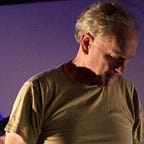What part of the brain does spatial reasoning?
Spatial reasoning is a whole brain phenomenon, but we can identify some specific areas that contribute to it.
The key area for spatial reasoning is the grid cells of the entorhinal cortex in the temporal lobe. This is an array of cell clusters organized in a triangular grid something like this:
Each cluster can involve thousands of neurons, and some of the neurons can have many tens of thousands of neurites (axons and dendrites) connecting locally.
In animals, we have observed activations of clusters corresponding to movement in a space. Evidence suggests that people and animals map (make logical correspondences) between places in their lives and locations in the grid array. Each cluster is highly interconnected within itself, and less highly connected to adjacent clusters, forming a small world network hierarchy.
The array of grid cells isn’t a map so much as a medium on which a multitude of maps can be placed. So at one time the grid cells might represent a map of your house, and in the next moment the same array of grid cells might represent a map of you neighborhood, your city, and even the world. These different mappings are encoded in the details of connections within and between clusters.
The array of grid cells is used for mapping horizontal landmarks, but it can also hold a mapping of any other 2D conception. It can map your understanding of the floors in a tall building (while you are waiting for the elevator), then quickly switch to the layout of each floor the elevator stops at. It can map the layout of important content on a diagram, even if the diagram is about abstract content. It can hold the relations of an academic field, even though the map of the elements and relations are of our own construction.
We have two temporal lobes, and each has an array of grid cells. The two arrays can hold different maps at the same time. So when we are imagining 3D spaces and their contents, one will map the base plane (floor) of the space, and the other will map various vertical planes that define the space. With practice, we can can manipulate both maps to gain detailed understanding of a 3D space.
People who are really good at conceiving, manipulating, and exploiting 3D space seem to have another brain advantage. Their grid cells in each hemisphere are richly connected through the anterior commissure, a white matter tract that connects the hemispheres in front of the corpus callosum. This trait is common between highly skilled mathematicians and highly trained musicians, perhaps others. Musicianship seems to rely heavily on the grid cells.
Spatial reasoning requires more than a map. Understanding what’s on the map is also important, which is why the grid cells are very close to the hippocampus on each side. The hippocampus connects us to our memories, and it holds our sense of place. Memories activate maps in the grid cells, and navigation to grid cells activates memories associated with mapped grid cell locations. Moreover, the hippocampus has place cells that represent important locations. The close connection between grid cells and place cells allows us to quickly orient to places we’ve been before and to anticipate and find our way to known locations when we are some distance away.
The use of maps and the importance of places is guided by attention, so the prefrontal cortex is heavily involved in spatial reasoning. Whether to see a space as 2D or 3D depends on our intentions, and whether we are currently paying attention to a map of the the house or the neighborhood depends on what we are attending to. Fortunately, we can switch between these different views of the world very quickly, and it seems that attentive processes in the prefrontal cortex contributes to such changes.
Our 2D and 3D mapping of the world is not any entirely logical process. Our state of arousal from the amygdala, surprising sensory input from the thalamus, random memories from the hippocampus, and other emotional input can direct and redirect the maps we use at any moment, affecting how we see the world.
I hope this quick tour of the brain provides a good summary of how we perform spatial reasoning. Perhaps you noticed that just about every description of how we reason depends on the thalamus, amygdala, hippocampus, and entorhinal cortex, so there’s nothing new here. Everything in the brain is connected, and everything the brain does involves just about every part of it.
